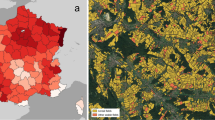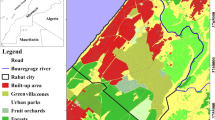Abstract
Following a workshop exercise, two models, an individual-based landscape model (IBLM) and a non-spatial life-history model were used to assess the impact of a fictitious insecticide on populations of skylarks in the UK. The chosen population endpoints were abundance, population growth rate, and the chances of population persistence. Both models used the same life-history descriptors and toxicity profiles as the basis for their parameter inputs. The models differed in that exposure was a pre-determined parameter in the life-history model, but an emergent property of the IBLM, and the IBLM required a landscape structure as an input. The model outputs were qualitatively similar between the two models. Under conditions dominated by winter wheat, both models predicted a population decline that was worsened by the use of the insecticide. Under broader habitat conditions, population declines were only predicted for the scenarios where the insecticide was added. Inputs to the models are very different, with the IBLM requiring a large volume of data in order to achieve the flexibility of being able to integrate a range of environmental and behavioural factors. The life-history model has very few explicit data inputs, but some of these relied on extensive prior modelling needing additional data as described in Roelofs et al. (2005, this volume). Both models have strengths and weaknesses; hence the ideal approach is that of combining the use of both simple and comprehensive modeling tools.



Similar content being viewed by others
References
Akçakaya H.R., (2002) RAMAS Metapop: Viability Analysis for Stage-structured Metapopulations. Version 4.0. Applied Biomathematics, Setauket New York, USA
Akçakaya H.R., Burgman M.A., Ginzburg L.A., (1999) Applied Population Ecology Using RAMAS EcoLab Sinauer Associates, Sunderland Massachusetts, USA
Baillie, S.R., Crick, H.Q.P., Balmer, D.E., Beaven, L.P., Downie, I.S., Freeman, S.N., Leech, D.I., Marchant, J.H., Noble, D.G., Raven, M.J., Simpkin, A.P., Thewlis, R.M. and Wernham, C.V. (2002). Breeding Birds in the Wider Countryside: their conservation status 2001. BTO Research Report No. 278. BTO, Thetford. (http://www.bto.org/birdtrends2001/wcrskyla.htm)
Bennett, R.S., Dewhurst, I., Fairbrother, A., Hart, A.D.M., Hooper, M., Leopold, A., Mineau, P., Mortensen, S., Shore, R.F. and Springer, T. (2005). A new interpretation of avian and mammalian reproduction toxicity test data in ecological risk assessment. Ecotoxicology, this volume
Caswell H., 2001. Matrix Population Models: Construction, Analysis, and Interpretation 2 Sinauer Associates, Sunderland Massachusetts, USA
Chamberlain D.E., Wilson A.M., Browne S.J., Vickery J.A., (1999). Effects of habitat type and management on the abundance of skylarks in the breeding season J. Appl. Ecol. 36: 856–70
Delius J.D., 1965. A population study of skylarks Alauda arvensis Ibis 107: 466–91
Donald P.F., Evans A.D., Muirhead L.B., Buckingham D.L., Kirby W.B., Schmitt S.I.A., (2002) Survival rates, causes of failure and productivity of Skylark Alauda arvensis nests on lowland farmland Ibis 144: 652–64
FOCUS, 2001. FOCUS surface water scenarios in the EU evaluation process under 91/414/EEC. Report of the FOCUS working group on surface water scenarios, EC Document Reference SANCO/4802/2001-rev 2
Forbes V.E., Sibly R.M., Calow P., (2001) Toxicant impacts on density-limited populations: a critical review of theory, practice and results Ecol. Appl. 11: 1249–57
Lacy R.C., 2000. Considering threats to the viability of small populations with individual-based models Ecol. Bull. 48: 39–51
Odderskær, P., Prang, A., Poulsen, J.G., Elmergaard, N. and Andersen, P.N. (1997). Skylark reproduction in pesticide treated and untreated fields. Pesticide Research 32 Ministry of Environment and Engergy Copenhagen, Denmark
Roelofs, W., Crocker, D.R., Shore, R.F., Moore, D.R.J., Smith, G., Akcakaya, H.R., Bennett, R.S., Chapman, P.F., Clook, M., Crane, M., Dewhurst, I.C., Edwards, P.J., Fairbrother, A., Ferson, S., Fischer, D., Hart, A.D.M., Holmes, M., Hooper, M.J., Lavine, M., Leopold, A., Luttik, R., Mineau, P., Mortenson, S.R., Noble, D.G., O’Connor, R.J., Sibly, R.M., Spendiff, M., Springer, T.A., Thompson, H.M. and Top**, C. (2005). Case Study Part 2: Probabilstic modelling of long-term risk of pesticides on individual breeding success in birds and mammals. Ecotoxicology, this volume
Shore, R.F., Crocker, D.R., Akcakaya, H.R., Bennett, R.S., Chapman, P.F., Clook, M., Crane, M., Dewhurst, I.C., Edwards, P.J., Fairbrother, A., Ferson, S., Fischer, D., Hart, A.D.M., Holmes, M., Hooper, M.J., Lavine, M., Leopold, A., Luttik, R., Mineau, P., Moore, D.R.J., Mortenson, S.R., Noble, D.G., O’Connor, R.J., Roelofs, W., Sibly, R.M., Smith, G., Spendiff, M., Springer, T.A., Thompson, H.M. and Top**, C. (2005). Case Study Part 1: How to calculate appropriate deterministic long-term toxicity to exposure ratios (TERs) for birds and mammals. Ecotoxicology, this volume
Sibly R.M., Hansen F.E., Forbes V.E., (2000) Confidence intervals for population growth rate of organisms with two-stage life histories Oikos 88: 335–40
Sibly, R.M., Akcakaya, H.R., Top**, C.J. and O’Connor, R.J. (2005). Population-level assessment of risks of pesticides to birds and mammals in the UK. Ecotoxicology, this volume
Top** C.J., Odderskær P., (2004). Modeling the influence of temporal and spatial factors on the assessment of impacts of pesticides on skylarks Environ. Toxicol. Chem. 23: 509–20
Top** C.J., Hansen T.S., Jensen T.S., Jepsen J.U., Nikolajsen F., Odderskær P., (2003). ALMaSS, an agent-based model for animals in temperate European landscapes Ecol. Model. 167: 65–82
Wolfenden H., Peach W.J., (2001). Temporal changes in the survival rates of skylarks Alauda arvensis breeding in duneland in northwest England. In: P.F. Donald, J. Vickery, (eds) The Ecology and Conservation of Skylarks Alauda Arvensis Sandy RSPB pp. 79–89
Acknowledgments
We wish to acknowledge the Pesticides Safety Directorate, Department for Environment, Food and Rural Affairs, UK for funding the workshop.
Author information
Authors and Affiliations
Corresponding author
Rights and permissions
About this article
Cite this article
Top**, C., Sibly, R., Akçakaya, H. et al. Risk Assessment of UK Skylark Populations Using Life-History and Individual-Based Landscape Models. Ecotoxicology 14, 925–936 (2005). https://doi.org/10.1007/s10646-005-0027-3
Accepted:
Published:
Issue Date:
DOI: https://doi.org/10.1007/s10646-005-0027-3




